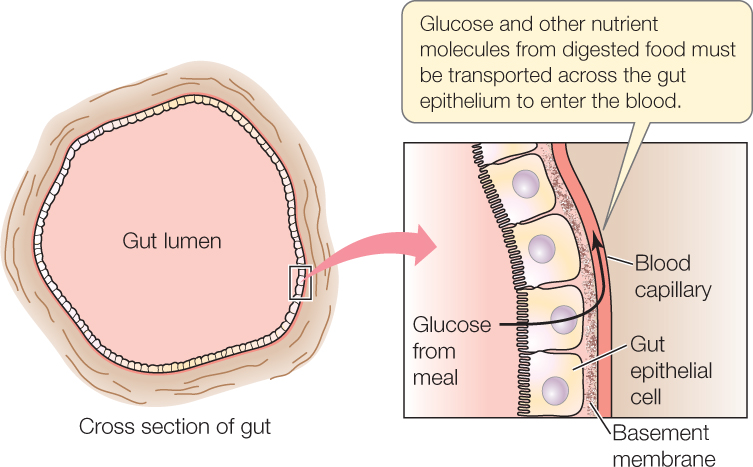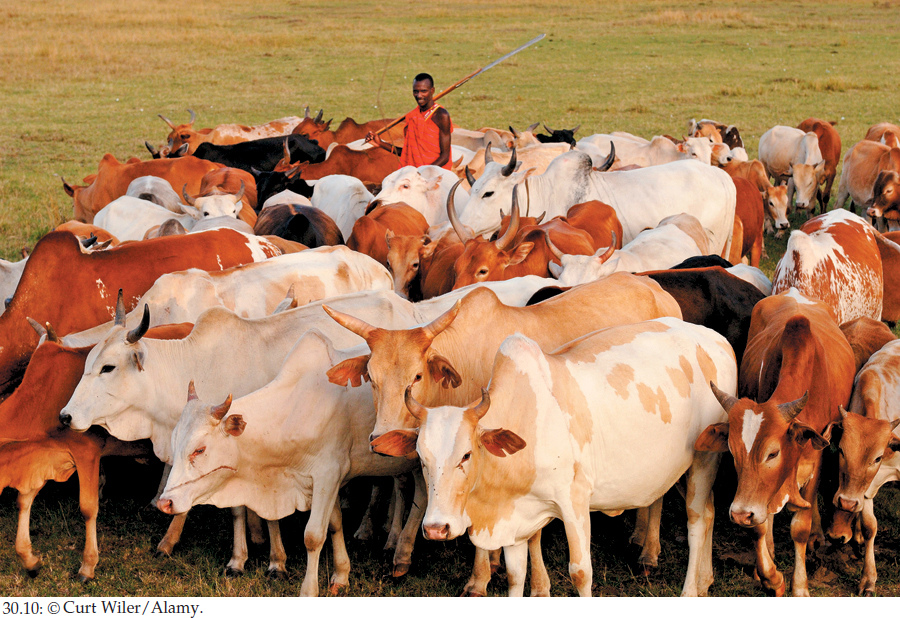CONCEPT30.3 The Digestive System Plays a Key Role in Determining the Nutritional Value of Foods
After animals ingest foods, the foods usually pass through a tubular digestive tract—a tubular gut—in most cases. The foods enter at the mouth, and later their indigestible components exit as feces at the other end of the tube, the anus. Exceptions to this pattern exist. For example, in animals with symbiotic microbes (see Concept 30.2), sugars or other nutritional compounds synthesized by the microbes enter the animal tissues directly without needing to pass through the digestive tract. For the rest of this chapter we will focus mainly on food processing by the digestive tract.
The inner walls of the digestive tract are lined, from mouth to anus, with an epithelium (usually a simple epithelium; see Figure 29.13):

633
After being ingested, food materials are in the gut lumen on the inside of this epithelium (i.e., enclosed by the epithelium). The blood vessels of the gut are located in the tissues in the walls of the gut, surrounding the epithelium. Thus for food materials to enter the blood for transport to cells throughout the body, they must cross the gut epithelium. Most materials in the foods animals ingest cannot do that. The molecules of carbohydrates, lipids, and proteins in foods are far too large and complex to cross the gut epithelium.
The digestive system’s principal function is to perform two processes that together permit food materials to be taken into the blood and used: digestion and absorption. Here we define them in ways that apply to most animals. Digestion is the breakdown of food molecules in the gut lumen by enzyme action to produce smaller molecules that can cross the gut epithelium to enter the blood. Absorption is the process of transporting molecules from the gut lumen into the blood. The mechanisms of both digestion and absorption are specific for certain types of molecules. For the most part, the molecules that an animal can absorb are the very ones that the animal’s digestion produces.
The digestive systems of all animals carry out digestion and absorption. This is true even though digestive systems are diverse in their detailed anatomy and physiology (FIGURE 30.8).
Digestive abilities determine which foods have nutritional value
To see a critically important aspect of animal nutrition, let’s consider what happens if a person eats cellulose, the principal material in the cell walls of plants (see Concept 2.3). Cellulose molecules are very large, and they are unable to pass through the gut epithelium from the gut lumen into the blood. Moreover, humans have no way to digest cellulose: we have no cellulose-digesting enzymes, and unlike ruminants, we don’t have a rumen stocked with symbiotic microbes that can break down cellulose molecules into smaller pieces. As a consequence, we get no nutritional benefit from cellulose. Even though cellulose molecules contain a lot of chemical energy that would be useful for us, we cannot access that energy. If we eat cellulose, it simply stays inside our gut lumen and is eliminated in our feces.
This example illustrates that the nutritional value of a food depends on more than its chemical composition. It also depends on an animal’s ability to process the food so its components can be absorbed into the blood and delivered to the cells of the animal’s body.
Animals are diverse in the foods they can digest
Each digestive enzyme is specific in the types of chemical bonds it can break (although some enzymes are more specific than others). FIGURE 30.9 shows the digestion of a short protein molecule by three protein-digesting enzymes (carboxy-peptidase B, chymotrypsin, and trypsin). Each of these three enzymes acts specifically on peptide bonds between particular types of amino acids. Together, the enzymes break three of the peptide bonds in the protein, producing four small molecules from the single large molecule.

634
Because each digestive enzyme is specific in the types of bonds it can break, an animal’s ability to digest foods is strictly determined by the particular digestive enzymes the animal synthesizes. An animal can break the types of chemical bonds in foods for which it has suitable digestive enzymes. It generally cannot break other types of bonds.
As a consequence of these principles, two related species can eat the same food but derive different nutritional value from it (because different sets of digestive enzymes may have evolved in the two species). For a vivid example, let’s contrast species of mammals that eat lots of insects—such as insectivorous (insect-eating) bats—with other species of mammals that avoid insects or eat few of them. Insects are rich in a sugar named trehalose, which is not found in most other foods consumed by mammals. For trehalose in a mammal’s gut lumen to be absorbed into the mammal’s blood, each molecule of trehalose must be broken into two smaller molecules by a digestive enzyme called trehalase:

Insectivorous mammals have evolved the ability to produce lots of trehalase. Thus when they ingest insects, they are able to digest the trehalose in them, breaking each molecule into two molecules of glucose that they absorb into their blood and use. These mammals get a great deal of nutritional benefit from trehalose in their diet. In contrast, related species of mammals that do not eat insects typically have not evolved the ability to produce much trehalase. If they eat trehalose, they get almost no nutritional value from it. Thus two related mammals could eat identical meals of insects and obtain radically different nutritional benefits.
As we have seen, cellulose provides another example of these same points. Humans get no nutritional value from cellulose because we cannot digest it, but ruminants obtain a great deal of nutritional value from it because their symbiotic microbes break down cellulose. Among insects, some species are like people and get no nutritional value from cellulose. By contrast, certain wood-eating insects produce cellulose-digesting enzymes that allow them to digest cellulose and absorb it. And other wood-eating insects, such as some termites, maintain symbioses with microbes that break down cellulose for them.
Digestive abilities sometimes evolve rapidly
One of the most revealing discoveries in the study of human nutrition in the past decade concerns the digestion of milk sugar, lactose, by various human populations. When humans are first born, we produce the digestive enzyme lactase in our intestines. For this reason, babies can readily digest lactose in their mother’s milk, breaking each lactose molecule into two parts (the monosaccharides galactose and glucose) that the infants can absorb and use. In most human populations, however, people stop making lactase as they grow older; by the time they are adults, they make little or no lactase and thus are unable to digest and use milk sugar. Most African tribes follow this pattern: the people in the tribes make lactase as infants but lose that ability in adulthood.
Researchers went to Africa to answer the question, What happens in African tribes that raise cattle? Certain tribes maintain herds of cattle that have enormous cultural significance. Tribal life is centered on caring for the herds. The cattle are used as special gifts, and the people use the blood and milk of the cattle as important foods (FIGURE 30.10).

The researchers discovered that in many cattle-raising tribes, the people have evolved the ability to synthesize lactase in adulthood. Thus, unlike most adult Africans, adults in the cattle-raising tribes can digest milk sugar all their lives. This ability to synthesize lactase in adulthood has evolved independently several times. We know this because the gene mutations responsible for lactase synthesis differ among tribes.
From this research came another important discovery—that nutritional processes can evolve rapidly in human populations. Some of the mutant genes responsible for adult lactase synthesis in African tribes first appeared, through the process of mutation, only about 5,000 years ago (a short time on an evolutionary time scale). Today these genes are widespread in the tribes where they occur.
Almost 100 percent of white-skinned people in northern Europe, such as white-skinned Dutch and Danish people, synthesize lactase as adults. How can this be? A large body of evidence indicates that the relevant mutant genes in northern European populations first appeared after their ancient ancestors migrated out of Africa and into Europe. Thus mutations that maintain lactase production in adulthood occurred in the European populations independently from the mutations in the African tribes we just discussed. Possibly the mutant genes in northern Europe were favored by natural selection because people there eat large amounts of milk, cheese, and other dairy products.
635
When people from northern Europe immigrated to North America centuries ago, all of them probably had genes enabling them to synthesize lactase in adulthood. However, they intermarried with people who immigrated from other parts of the world. Today about 75 percent of white-skinned people in North America produce lactase in adulthood, but 25 percent do not and may have sufficient problems with digesting dairy products to be lactose intolerant.
Digestive abilities are phenotypically plastic
Individual animals—from fish to mammals—often modify their production of digestive enzymes during their lifetimes in response to the types of foods they are eating. In this way individuals can adaptively modify the nutritional values of foods.
If a lab rat has been eating a low-protein diet but is switched to a high-protein diet, its digestive tract starts to increase production of protein-digesting enzymes within 24 hours. A week later, when the response is fully developed, the rat will secrete protein-digesting enzymes at rates that are five times higher than before the switch in diet. By means of this digestive phenotypic plasticity, a rat that starts to eat a lot of protein soon develops a greatly enhanced ability to digest protein and thus tap dietary proteins for energy and amino acids. Conversely, when a rat that has been eating lots of protein is suddenly deprived of protein, it will greatly reduce production of protein-digesting enzymes.
Similarly, if a rat is given increased amounts of carbohydrates in its diet, it will increase production of carbohydrate-digesting enzymes. If it is given lots of lipids, it will increase lipid-digesting enzymes.
Parallel changes take place in absorption mechanisms. For example, researchers have observed that when people start to eat lots of sugar after a period of eating little sugar, their absorption mechanisms for taking up the products of sugar digestion become more effective.
CHECKpointCONCEPT30.3
- Are the terms “digestion” and “absorption” interchangeable? Compare the two.
- Humans derive no energy from the cellulose molecules in brussels sprouts. Does this imply that cellulose molecules, and brussels sprouts in general, are low in chemical energy?
- Why might the ability to produce lactase into adulthood be beneficial to people living in cultures heavily dependent on dairy products?
At this point we have discussed the fundamentals of nutrition, food gathering, and extraction of energy and nutrients from food. With this background, let’s now take a closer look at the digestive systems of vertebrate animals.